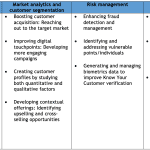On the Edge of Edge: Why Advancements in Edge Computing Could Shift the Paradigm for Remote Connectivity, Internet of Things and Digital Development
It is time for the digital development field – international development professionals focused on the effective use of digital communication technologies in emerging markets – to start paying closer attention to edge computing. This technology is simultaneously established and cutting-edge, and it can be described as localized cloud computing. By definition, it brings both computation and data storage closer to the sources of data – i.e., internet users and their devices. Practically speaking, it involves installing edge servers – boxes that contain a computer with a lot of processing capacity and memory – on cell towers.
From a connectivity perspective, edge computing offers the ability to deliver content from the edge server directly to consumers’ devices, with ultra-low latency – instead of transmitting that content from more distant, centralized hubs across a regular cellular network. And given these servers’ proximity to people, users in many cases could access their content affordably (or even for free) via Wi-Fi. This presents clear advantages over the mobile data connections most people use to access content on the internet, which generally charge customers based on the amount of data they use.
As the costs for data processing and memory gradually come down (setting aside the current chip shortage), it is increasingly affordable and practical for people and organizations to store data and run applications on edge servers. While the content does need an internet connection to be updated, the evolving capabilities of edge computing raise increasingly important conceptual questions: How could digital development projects and small businesses take advantage of this massive amount of potential memory and computing power to work in remote locations? What edge computing business models could provide people in these markets with meaningful content consumption experiences? What kind of edge services will be profitable? And what kind of businesses will provide edge services – will it be established mobile network operators (MNOs) or tower companies working at the national level, community-based businesses, or something more nimble?
Edge Computing in International Development
There are many trends in digital development and the telecommunications industry that seem to indicate a growing role for edge computing in international development, including several I’ll discuss below.
The mobile industry is preparing for edge computing
In October 2020, 19 GSMA members formed the Telco Edge Cloud (TEC) taskforce to examine potential business models for edge computing. This is significant, as the GSMA is the global trade association for mobile network operators. While a lot of the TEC taskforce’s focus has to do with leveraging the emerging capacity of 5G cellular networks in denser population locations, it also includes business model considerations for remote locations. Since MNOs make their money from data charges, and edge computing can reduce the cost of data, these companies will need to adapt. The taskforce’s initial white paper, which proposes six potential revenue models, gives the impression of a group of oil company executives trying to figure out how to make money from solar and wind energy.
It’s already happening
The N50 project is a new and growing collaboration of companies and content providers working to develop and deploy edge solutions. Project members Intel, Africa Mobile Networks, Mwabu and Geeks Without Frontiers are already piloting an edge solution in the village of Luumbo, in Zambia’s rural Gwembe district. This proof-of-concept deployment aims to store health, education, agriculture and entertainment content on the edge device, and make it available without users having to use a mobile data connection such as 3G or 4G. Instead, they could access it via Wi-Fi. When describing the origin of N50, Intel’s Dan Gutwein, who manages the coalition, told me in an interview that he was struck by data in the GSMA State of Mobile Internet Connectivity 2020 report that showed a significant part of the usage gap—i.e., low internet use by people in areas with a mobile data signal—was driven by a lack of relevant content in people’s local languages. Gutwein believes that, once people get accustomed to accessing useful content in their preferred languages freely, either from the edge server or via temporarily free mobile data, they will be willing to pay for data. “This is a business model issue … cloud providers moved to the edge a long time ago,” he explained, describing the standard industry practice of seeking efficiencies in content delivery by distributing select content via edge servers. “Only the last mile is new.”
Edge is ideal for open-source solutions
Quality open-source edge software already exists and is achieving uptake. For example, Magma, an open-source, edge-friendly mobile network-building software, continues to expand in usage. The platform offers the benefit of enabling connections between existing MNOs and new infrastructure providers, such as cell tower companies, in order to expand rural infrastructure. And in February 2021, the neutral Linux Foundation took over stewardship of the Magma project from Facebook, joining forces with other organizations to create the Magma Core Foundation, and adding several members. These developments may make users more comfortable working with this particular edge technology.
Multi-stakeholder progress is underway
The Internet Corporation for Assigned Names and Numbers (ICANN) is a multi-stakeholder group that coordinates the management of the Domain Name System, which ensures that all users of the internet can find all valid addresses. In August 2020, ICANN released a Hyperlocal Root Zone Technical Analysis focused on the use of more local, decentralized approaches to content distribution to reduce latency – including by using “hyperlocal root service deployments.” In essence, this analysis explored how to organize the logistics of internet content distribution, given the trend towards decentralization efforts like edge computing. Given ICANN’s role of maintaining internet addresses and domain names for the internet globally, their analysis should have wide influence.
Corporate and government momentum is building
Google Cloud recently partnered with SpaceX’s Starlink low-earth orbit satellite network, “to help facilitate network connections for customers who are on the edges of the footprint of existing network access.” And Kenya has recently licensed community networks, which should clear the way for edge computing-based network solutions.
Business Implications of the Growth of Edge Computing
The emergence of edge computing will present a number of challenges and opportunities to the businesses that aim to leverage it to boost rural internet connectivity and accomplish other development goals. I’ll explore some of these below.
One challenge to existing connectivity business models
Increasing edge computing capacity challenges current connectivity business models, which charge customers both for live services delivered only to individual users, such as calls or texts, and for videos, news, entertainment and other online content that’s accessed by many users. The more this widely accessed content can be preloaded or stored on an edge server on a cell tower, the less that content needs to be sent live all the way across the network. Caching content – i.e., storing a copy of it – in locally placed edge computing servers lowers costs and decreases revenues. That’s why the GSMA TEC taskforce executives are looking to create new revenue models, and why the oil industry comparison is accurate: Just as more people switching to electric cars will reduce demand for gasoline, more online services switching to edge computing will reduce demand for networks to deliver live content from the center to the edge of their coverage areas – reducing the amount of data revenue MNOs can earn.
The mobile phone equivalent of a Chromebook
If you imagine an edge server on a cell tower running the apps you use and storing all the data that you currently run and store on your phone, you realize that your device could be less “smart” – and less expensive. In this scenario, a twin of your Facebook or LinkedIn account data (to take some common examples) would live on the edge server, and you wouldn’t have to bother updating these apps on your phone; they would be updated on the tower, for everyone at the same time. This opens the possibility of a mobile phone equivalent of Google’s cloud storage-based Chromebook, in which as much hardware as possible is stripped away, leaving only the bits that allow the phone to retrieve, display and interact with data from/on a server. This approach would make the device cheaper. Call it an edge phone, which might be something akin to the “smart feature phone” described in the 2021 GSMA State of Mobile Internet Connectivity report. This sort of phone could help bring content access prices down in regions like Africa, where smartphones, recently described as a new tax on the poor, continue to be out of reach for many. According to Connecting Africa, “Sub-Saharan Africa still has the most expensive data prices in the world.” And according to the GSMA, “Accounting for the important differences in income across countries, the median price of African spectrum assignments [i.e., sections of the radio spectrum allotted to individual companies] over the 2010 – 2019 period was more than four times the median in developed markets.” Simpler device requirements could also create opportunities for indigenous handset manufacturers, such as Mara (in Rwanda) or AfriOne (in Nigeria).
The value of local ownership
One of the most interesting things in the GSMA white paper discussing edge computing is the GSMA’s openness to interoperable, federated telco edge computing platforms. This seems to suggest that small, new players – which otherwise cannot afford to buy national operating licenses, or to lease spectrum for their signals – might be able to enter the market. And technology from companies like MobiledgeX already allows MNOs to combine their edge-based clouds. Plus, the presence of a visible, well-functioning edge server in a community may give residents a sense of ownership over it, especially if they rely on it to store their data, and if it offers useful services – and affordable access to smart devices – to the community.
Internet of Things (IoT), local feedback loops and monetization
While edge computing is exciting for its ability to bring content to remote internet users, it is also well-suited to collecting data and information in these communities, especially from sensor networks. Edge servers on cell towers empowered with theoretically endless memory and computational power are very well-placed to collect and analyze data from locally deployed sensors. On the one hand, users’ phones are great data collectors: Modern smartphones contain approximately 20 different sensors. For example, their cameras can collect data on sunlight and their accelerometers can observe movements of people in a community. Yet there are far more uses for sensors, particularly those designed specifically for agriculture, the main form of employment in many developing countries. These may include monitors to detect water levels, the proportion of time when the sky is sunny or cloudy, soil acidity levels, livestock health and more. Having enough of this data stored on a local edge server could allow artificial intelligence running on the edge server to suggest when farmers should plant, whether the fertilizer they used was working and so on. Better data on crops could also help inform customized financial products timed to the harvest season. Farmers uploading data to an edge server could even agree to combine their data and re-sell it to researchers, or to the developers of relevant machine learning algorithms who are in search of training data. Development organizations are well-placed to serve as partners in these efforts, working with both local communities and companies looking to test their business models in under-resourced environments.
The growth of low earth orbiting satellites
The services and price points of low earth orbiting (LEO) satellites promise to be complementary to edge computing. These satellites aim to offer service in remote locations, and their reach is rapidly expanding: March saw the 41st launch of Starlink satellites, bringing the total deployed to over 2,000 out of a potential 42,000. While still pricey, the service offers a median download speed of 104 megabits per second, as measured by Ookla, the operator of an internet speed test. OneWeb, which had gone bankrupt in March 2020 but got back in the running thanks to investments by the U.K. government and Bharti, trails in terms of numbers but not ambition. And Amazon has two complementary programs, the nascent Project Kuiper LEO satellite network and AWS Ground Station, which offer (quite literal) vertical integration by delivering content via their own satellites to their own ground station, with onward distribution per customer demand. It is easy to imagine a combination of these two services working with edge networks in remote locations. In light of this momentum, in September 2021, two different satellite groups began calling for an open standard for satellite equipment, allowing for interoperability between platforms. Their ideas echo the thinking behind the creation of the Android operating system, as well as the systems created under the Telecom Infra Project, such as OpenRAN. Open standards should help reduce the cost of connecting edge systems to satellite backhaul.
The challenge of end-to-end encryption of YouTube and some other services
While content caching sounds simple and cost-effective, there is one major problem for much of the content that people would likely want to cache—including content from sources such as YouTube: This content is encrypted end-to-end to protect intellectual property. This means cache servers cannot know what the content is, cannot identify which content multiple people are accessing, and cannot cache it. N50 member PicoNETS is trying to tackle this problem by linking up with the AWS Wavelength service, which “embeds AWS compute and storage services within 5G networks, providing mobile edge computing infrastructure for developing, deploying and scaling ultra-low-latency applications.” Since AWS in this case would be both a network AND a content provider, this linkage would make computing power at the edge much more powerful and accessible: A user would have just one company managing the entire content value chain, so if encryption is used, that company could cache its own content. In October Google provided further evidence of this trend, when it unveiled its competing Distributed Cloud service, which provides similar services to MNOs and other internet service providers. This may suggest a need for consumers to have access to multiple vertically integrated content providers (similar to the relationships many of us have with multiple streaming providers, like Netflix, Disney+, etc.). However, it may be the case that content providers will ultimately opt to collaborate to save on content delivery costs. Even if these companies’ initial focus is primarily 5G, the technology would likely be configurable for lower bandwidth environments. And try to imagine Amazon combining its Base Station and Wavelength businesses: They control so much content, these advancements that allow them to deliver their own content might sideline traditional carriers.
Cloud computing is not new, nor are cache servers or content delivery networks. But the edge computing solutions that leverage these technologies are still underdeveloped and under-considered approaches in international digital development. If sector stakeholders start planning and designing use cases now, we could combine the deployment of these technologies with desirable price points for remote and underserved internet users. We are at that rare juncture where we have an opportunity to develop a fundamentally new paradigm for internet connectivity and IOT.
Troy Etulain is a digital development and social innovation expert with 22 years’ experience in 35 countries.
Photo courtesy of Riaz Jahanpour for USAID Tanzania / Digital Development Communications.
- Categories
- Technology, Telecommunications



